Journalism, Mass Communications, Publishing… playlist:
Encyclopaedia Britannica Films playlist:
more at
The newspaper shown in this film is the Rockford Morning Star, Rockford, Illinois (now the Rockford Register Star). “Steps in the completion of a newspaper story from recording the incident through the taking & finishing of pictures, writing, editing, setting in type, printing the paper & distributing it are depicted. Produced by Encyclopedia Britannica Films, Inc. in collaboration with Kenneth E. Olson, LL.D, Northwestern University.”
Reupload of a previously uploaded film with improved video & sound.
Public domain film from the Library of Congress Prelinger Archives, slightly cropped to remove uneven edges, with the aspect ratio corrected, and one-pass brightness-contrast-color correction & mild video noise reduction applied.
The soundtrack was also processed with volume normalization, noise reduction, clipping reduction, and/or equalization (the resulting sound, though not perfect, is far less noisy than the original).
The Rockford Register Star is the Rockford, Illinois, metropolitan area’s primary daily newspaper.
The paper took its name with the 1979 merger of two influential Rockford competitors, The Register Republic (founded February 15, 1855, daily since January 6, 1873) and The Morning Star (founded March 20, 1888). In April 2007, Gannett announced it was selling the paper to Fairport, New York-based GateHouse Media.
The Register Star is the fifth highest circulation Illinois newspaper. As of September 2006, the newspaper’s Sunday circulation was 70,300—the 163rd largest in the United States…
A newspaper is a scheduled publication containing news of current events, informative articles, diverse features, editorials, and advertising. It usually is printed on relatively inexpensive, low-grade paper such as newsprint. By 2007, there were 6,580 daily newspapers in the world selling 395 million copies a day…
A wide variety of material has been published in newspapers, including editorial opinions, criticism, persuasion and op-eds; obituaries; entertainment features… classified ads; display ads, radio and television listings, inserts from local merchants, editorial cartoons, gag cartoons and comic strips…
In Boston in 1690, Benjamin Harris published Publick Occurrences Both Forreign and Domestick. This is considered the first newspaper in the American colonies even though only one edition was published before the paper was suppressed by the government. In 1704, the governor allowed The Boston News-Letter to be published and it became the first continuously published newspaper in the colonies. Soon after, weekly papers began publishing in New York and Philadelphia. These early newspapers followed the British format and were usually four pages long… In 1783, the Pennsylvania Evening Post became the first American daily…
In 1764, the Quebec Gazette was first printed June 21, 1764 and remains the oldest continuously published newspaper in North America as the Quebec Chronicle-Telegraph…
The first newspaper in South America was Diario de Pernambuco, established in 1825…
Offset printing is a commonly used printing technique in which the inked image is transferred (or “offset”) from a plate to a rubber blanket, then to the printing surface…
Development of the offset press came in two versions: in 1875 by Robert Barclay of England for printing on tin, and in 1903 by Ira Washington Rubel of the United States for printing on paper…
Lithography was initially created to be a low cost method of reproducing artwork. This printing process was limited to use on flat, porous surfaces because the printing plates were produced from limestone. In fact, the word ‘lithograph’ historically means “an image from stone…”
As the 19th century closed and photography captured favor, many lithographic firms went out of business. Photoengraving, a process that used halftone technology instead of illustration, became the leading aesthetic of the era. Many printers, including Ira Washington Rubel of New Jersey, were using the low-cost lithograph process to produce copies of photographs and books. Rubel discovered in 1901—by forgetting to load a sheet—that when printing from the rubber roller, instead of the metal, the printed page was clearer and sharper. After further refinement, the Potter Press printing Company in New York produced a press in 1903. By 1907 the Rubel offset press was in use in San Francisco…

